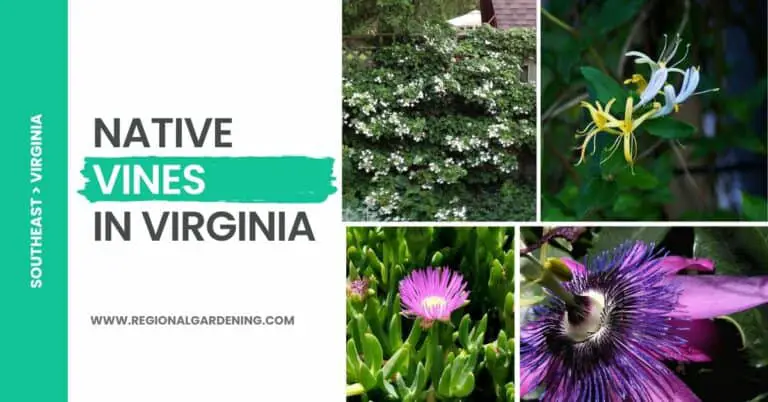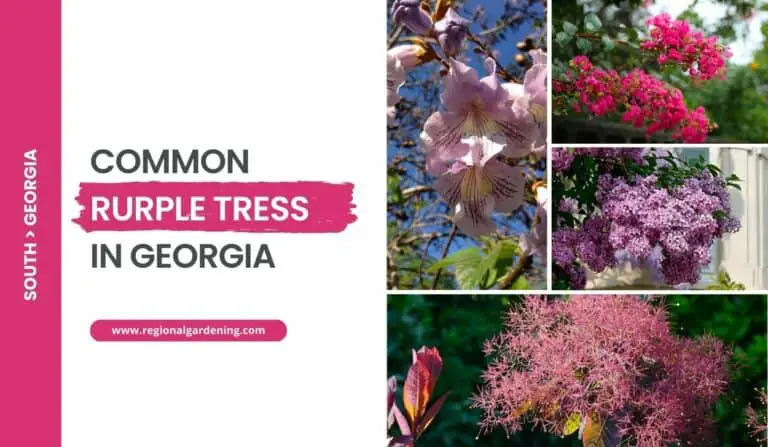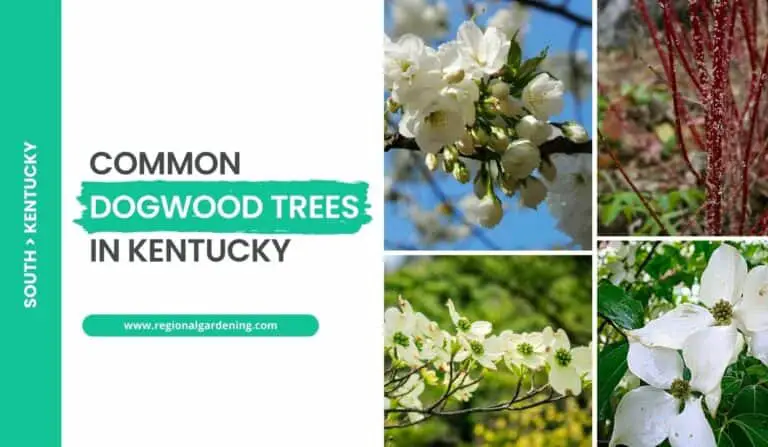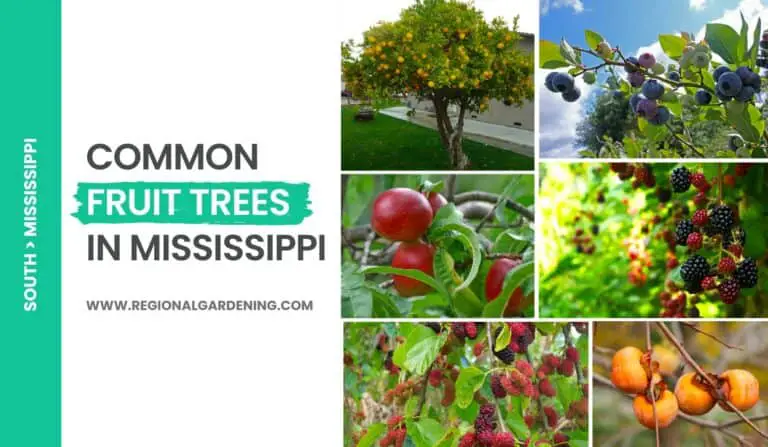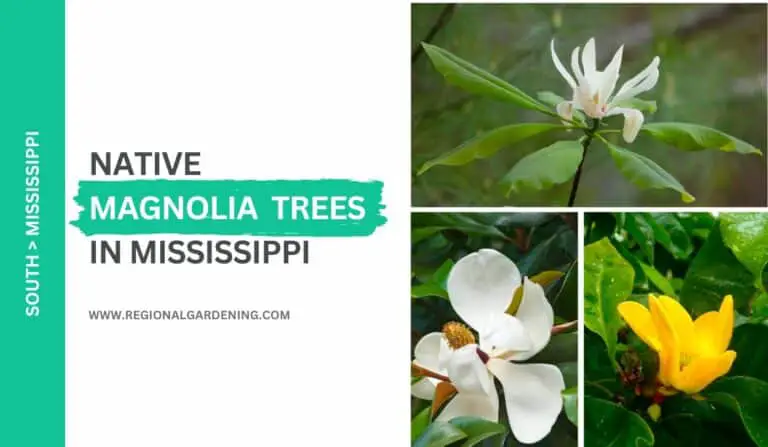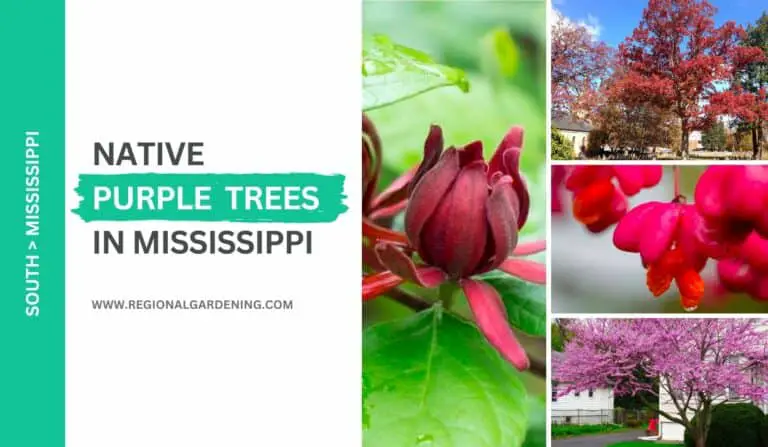17 White Flowering Trees In Mississippi (Pictures & Care Tips)
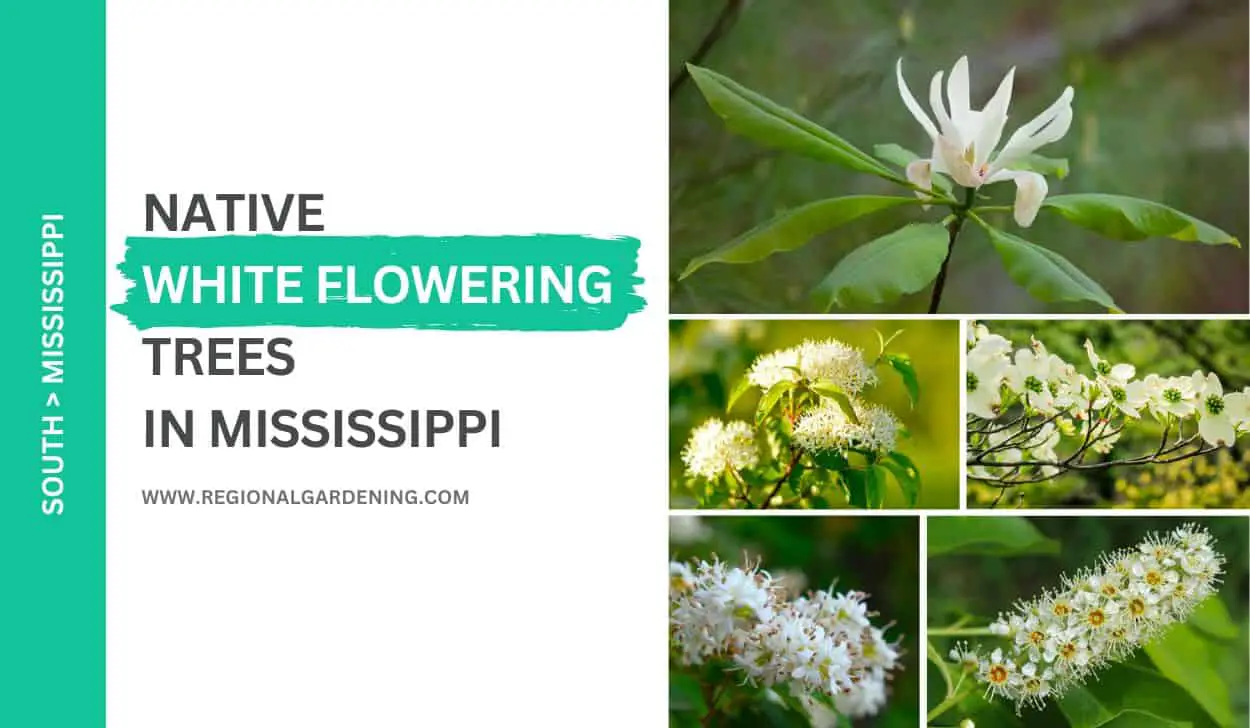
Do you wish to have a backyard garden that is adorned with the elegance of white flowering trees? If you’re an avid gardener or a landscaping enthusiast, white flowering trees are a perfect choice to elevate the beauty of your outdoor space while nurturing the local ecosystem by attracting essential pollinators like bees and butterflies.
If you call Mississippi home, you’re in luck, as this state is blessed with over 17 delightful varieties of white flowering trees. And, in this article, we’ll delve into 17 of the most commonly found native white flowering trees in Mississippi.
So, let’s begin exploring.
1. Flowering dogwood
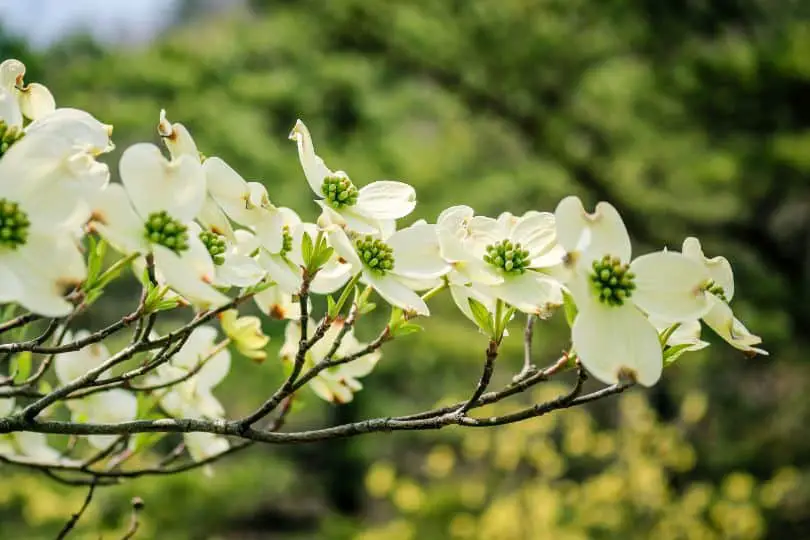
- Scientific Name: Cornus florida L.
- Common Name(s):Flowering Dogwood
- Mature Height: 40.0′
- Native Range: Throughout Mississippi.
- Fruits/Flowers: Yellowish-white flowers.
- Uses: Valuable for wildlife, excellent ornamental capabilities.
One of the most commonly found white flowering trees in Mississippi is the flowering dogwood, a deciduous tree with simple, opposite leaves. The leaves are oval-shaped, pointed at the tip, and bright green on top with a paler whitish-green tint on the bottom.
The tree’s twigs are slender and range in color from red to yellow-green to purple in the first winter before becoming gray-brown to brown. The tree bears clusters of bright red drupes encircled by sizable, white bracts that resemble flowers. The drupes are about 0.5″ long and ovoid in shape, and the flower is monoecious and perfect, with 0.25″ yellowish-white petals.
The Flowering Dogwood has a modest growth rate and a short lifespan of less than 50 years, reaching a maturity height of 40.0′. It is shade tolerant and has a limited tolerance for drought and fire.
The tree is often found as an understory species alongside other hardwoods in moist, rich, and deep soils near stream banks and slopes. It is indigenous to the eastern United States, from Mississippi River Delta counties through Kansas, Oklahoma, and Texas.
Flowering Dogwood is highly recognized for the wildlife benefits it provides. Various animals feed on its seeds, fruits, flowers, twigs, bark, and leaves. The fruits of the tree are particularly appealing to animals, including birds such as ruffed grouse, bob-white quail, and wild turkey, due to their high calcium and fat content.
Chipmunks, foxes, skunks, rabbits, deer, beavers, black bears, and squirrels eat the fruits as well. Deer and rabbits frequently browse the tree’s foliage and twigs. Controlled burning in the spring can improve browsing quality by increasing protein and phosphoric acid levels.
The Flowering Dogwood has lumber value and is utilized in landscaping, in addition to its wildlife significance. It is frequently utilized in urban forestry projects and planted in abandoned strip mines.
The tree is a prized ornamental species that is often employed in street and landscape plantings. It can be used as a shrub border or backdrop species, or as single specimens in lawns to provide shade around patios. It is best suited for crops that do not receive full-day sun.
2. Buckwheat Tree
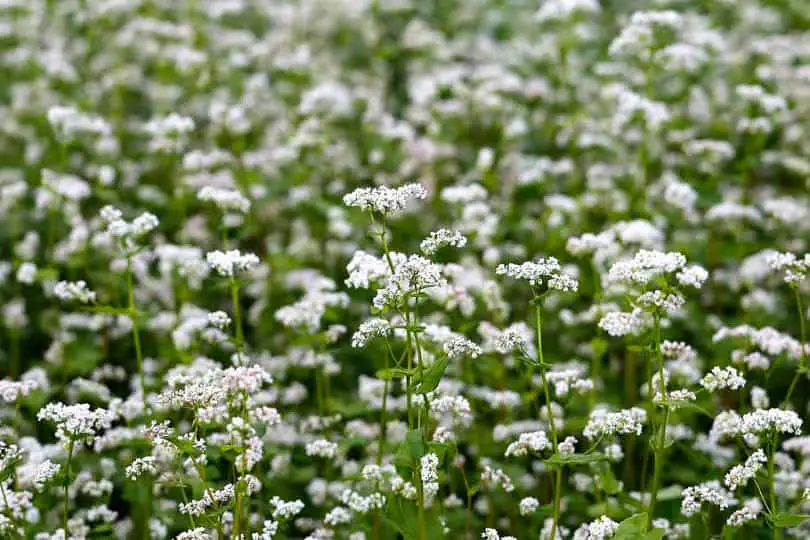
- Scientific Name: Cliftonia monophylla Britt.
- Common Name(s): Buckwheat Tree, black titi
- Mature Height: 30.0’ – 40.0’
- Native Range: Throughout Mississippi.
- Fruits/Flowers: Fragrant white flowers
- Uses: Landscaping
The Buckwheat Tree (Cliftonia monophylla Britt) is a tiny tree or shrub that grows to a mature height of 30.0′ – 40.0′. It is predominantly found on the Gulf Coastal Plain, from Georgia to northern Florida, and from extreme southeast Louisiana to the Gulf of Mexico. It is notably widespread in the Florida Panhandle, southern Alabama, and Mississippi’s southernmost counties. The leaves of the tree are simple, alternating, and persistent, and are dark green above and pale underneath. The leaves have lustrous, leathery surfaces and are oblong to lance-shaped.
The monoecious and aromatic flowers of the Buckwheat Tree bloom. The flowers are exquisite, with tall terminal racemes. They have 5-8 petals that range in color from white to light pink. The tree also bears nut-like drupes in colorful clusters. The drupes are winged, elliptical, and 0.25″ long.
In terms of physical characteristics, the Buckwheat Tree is a small tree or shrub with no known growth rate or longevity. It is sensitive to shade and drought. The tree is frequently found creating dense thickets along the edges of swamps, pocosins, and fertile river bottoms. It favors medium to coarse soils with a pH range of 4.5-5.5.
While the tree has no reported wildlife or wood value in the forest sector, it is prized in landscaping for its gorgeous leaf and fragrant blossoms. It is regarded as a rare and valuable landscaping plant, particularly in native habitats.
The Buckwheat Tree is heat-tolerant, disease-resistant, and insect-resistant. Although its wood is dense, close-grained, somewhat durable, and brittle, it has no commercial value in the forest sector. However, it is prized as fuel. Overall, the Buckwheat Tree is a distinct and appealing addition to native settings, adding beauty and scent to the environment.
3. Alternate-leaf dogwood
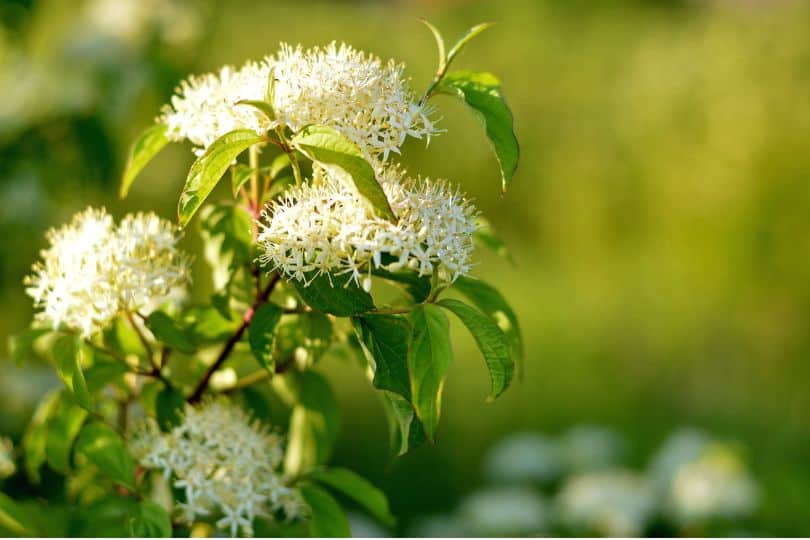
- Scientific Name: Cornus alternifolia L.
- Common Name(s):Alternate-leaf Dogwood
- Mature Height: 25.0’
- Native Range: Native to several counties of Mississippi
- Uses: Wildlife food and ornamental.
Aternate-leaf Dogwood is a deciduous tree with simple, alternate leaves. The leaves are oval to ovate, 3.0″ – 5.0″ long and 2.5″ – 3.5″ wide, and yellow-green above and lighter below. The twigs of the tree are slender and green to greenish brown in hue, and the buds are oblong to sharp with visible scales.
The tree produces blue-black to black lunate drupes in loose cymes, as well as white flowers with four rectangular petals.
The Alternate-leaf Dogwood has a maximum height of 25.0′, a modest growth rate, and a lifespan of more than 50 years. It is unaffected by anaerobic conditions and can withstand shade and drought.
This tree is commonly found in wet, rich soils along forest margins or near streams, sometimes in association with other hardwoods. It can be grown by seeds, bare roots, containers, or cuttings, and it can resprout and coppice.
The Alternate-leaf Dogwood is particularly beneficial for wildlife in terms of ecological importance. Many mammals and birds feed on the fruit and foliage of this plant. However, it has little commercial significance in the timber business. The toughness and strength of the wood were previously highly valued, and it was used to produce shuttles for weavers, tool handles, and tiny objects. Plastics are frequently employed for these applications in recent times.
The Alternate-leaf Dogwood is popular among landscape architects due to its horizontal branching behavior. It looks great as a tiny tree in the landscape and has a lovely winter habit. The bright spring blooms add to its allure.
4. Rough-leaf dogwood
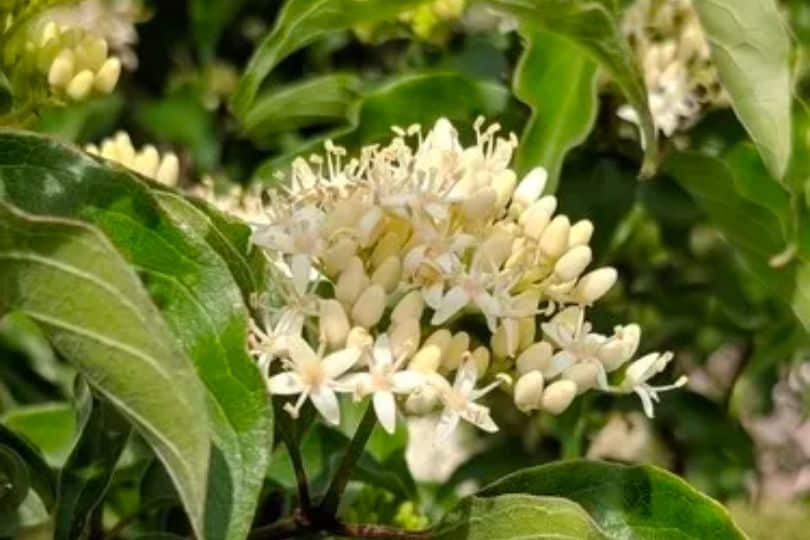
- Scientific Name: Cornus drummondii
- Common Name(s): Roughleaf Dogwood
- Mature Height: 48.0′
- Native Range: Ontario to Texas, including Mississippi
- Fruits/Flowers: Drupe berries in flat-topped clusters; white flowers in showy clusters
- Uses: Excellent ground cover for wildlife and ornamental.
Roughleaf Dogwood is a deciduous tree with simple, opposite leaves. The leaves are ovate to elliptical, with rough surfaces and stiff hairs, and are dark green above and paler below. With pubescence, the twigs become narrow and light green, then reddish brown to gray.
The tree also produces spectacular white flowers in clusters and small drupe berries with flattened tips. The bark is smooth and gray-brown at first, but it gradually turns flaky and fractured.
This tree can reach a mature height of 48.0 feet It grows quickly, reaching a maximum height of 48.0 feet after 20 years. It has a lifespan of more than 100 years. Roughleaf Dogwood tolerates moderate shade and is drought and fire-resistant. It is highly resistant to anaerobic environments. Seeds (with cold stratification), bare roots, containers, or cuttings can all be used for propagation. It is also capable of resprouting and coppicing.
Roughleaf Dogwood can be found in a variety of habitats and ecosystems, from moist stream banks to forested bluffs and limestone outcrops. It grows well in fine to medium-textured soils with pH levels ranging from 5.9 to 7.5. Its natural range includes Mississippi and extends from Ontario to Texas. It has been documented in Mississippi counties along the Mississippi River, in the state’s central region, and few specific counties. It is, however, likely to be found in other parts of the state as well.
Roughleaf Dogwood is a great ground cover for wildlife, and its fruit is a source of food for many bird species. White-tailed deer also browse on it. It does not, however, have any commercial timber value. It can be a good choice for making dense hedges or borders in landscaping.
5. Water Locust
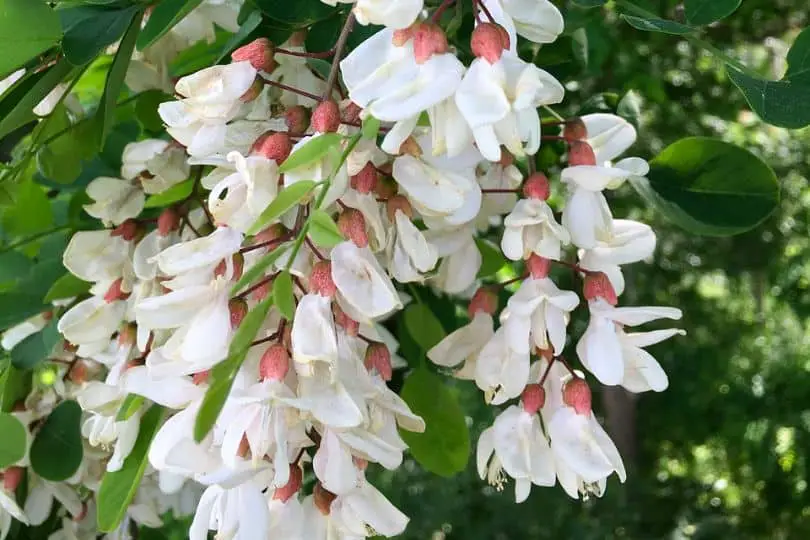
- Scientific Name: Gleditsia aquatica Marsh.
- Common Name(s): Water Locust
- Mature Height: 50.0’ – 60.0’
- Native Range: Throughout Mississippi.
- Uses: Wildlife food, stabilization of wet banks and marshes, fence posts, etc.
The Water Locust (Gleditsia aquatica Marsh) is a deciduous tree that grows in flood-prone river basins. It matures at a height of 50.0′ – 60.0′ and grows quickly. The leaves are compound pinnately or bipinnately, with 14-20 leaflets.
They have a glossy appearance because they are dull yellow-green on the top and dark green on the bottom. Water Locust twigs are slender to moderate in size and gray to red-brown in hue. They also have prominent thorns and zigzag branching. The tree has flat legume fruits containing 1-3 seeds. The blooms are exquisite, monoecious, and grouped in slender racemes. Water Locust bark is gray-brown and smooth, with small platelike scales on elder trees.
Water Locust is native to a wide region that extends from South Carolina to central Florida, west to eastern Texas, north to southern Illinois, and extreme southwestern Indiana. It is usually found in lush regions of river valleys that are prone to floods for much of the year.
The tree grows on fine to coarse-textured soils with pH levels ranging from 6.5 to 7.0. It is somewhat tolerant of anaerobic environments, shade-intolerant, and drought-resistant. The Water Locust can be grown by seed, container, or cutting. It is also capable of resprouting and coppicing.
This tree provides nutritional value as well as wildlife habitat. Its seeds, pods, and foliage are regarded as “Good” food for large and small animals, upland game birds, and waterfowl, and “Fair” for ducks. It is also used as cover for these types of species.
Because of its heavy, hard, robust, and lasting wood, the Water Locust is also planted to stabilize wet banks and marshes. The timber is mostly used to make fence posts. Water Locust trees can be found in nurseries, garden centers, and other plant dealers and distributors.
6. Honey Locust
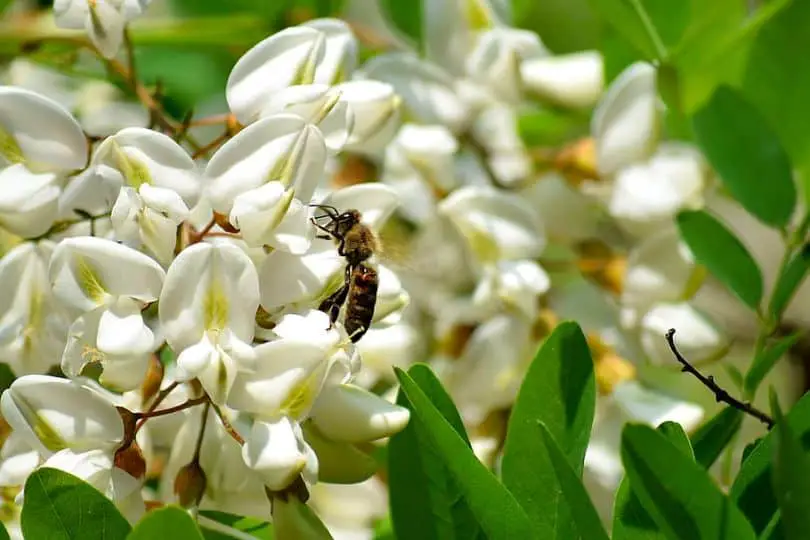
- Scientific Name: Gleditsia triacanthos L.
- Common Name(s): Honey Locust, Honey-shucks locust
- Mature Height: 75.0 feet
- Native Range: Scattered throughout Mississippi.
- Fruits/Flowers: Small white flowers.
- Uses: Wildlife food, timber for construction, furniture, etc.
The Honey Locust, commonly known as the Honey-shucks locust, has alternately arranged pinnately and bipinnately complex leaves that are deciduous. The leaves are shiny and dark green on top and yellow-green on the bottom.
The tree grows quickly, reaching a height of 75.0 feet. It has a rather long lifespan of more than 50 years. The Honey Locust is endemic to Pennsylvania, Michigan, Minnesota, South Dakota, Nebraska, Iowa, Kansas, Oklahoma, Texas, and Alabama, among other states.
The tree bears flattened thick-edged, and twisted legume fruits. These fruits have dark brown seeds that have been crushed. The Honey Locust produces monoecious flowers that might be flawless or flawed. The flowers are white and form axillary racemes. Cattle, goats, deer, and rabbits consume the pods and vegetative growth of this tree. Although not economically significant, the Honey Locust is also utilized for lumber.
Because of its hardiness and rapid growth, the Honey Locust is commonly planted as an ornamental tree in landscaping. It’s thin leaflets and open crown allow light to pass through, allowing shade-tolerant turfgrass and partial-shade perennials beneath to grow.
Honey Locust cultivars have been produced to manage the tree’s crown shape, branch angles, and leaf color. The majority of cultivars are thornless and unproductive. However, exploitation of this tree in cities is currently discouraged to prevent biodiversity loss.
7. Deciduous Holly
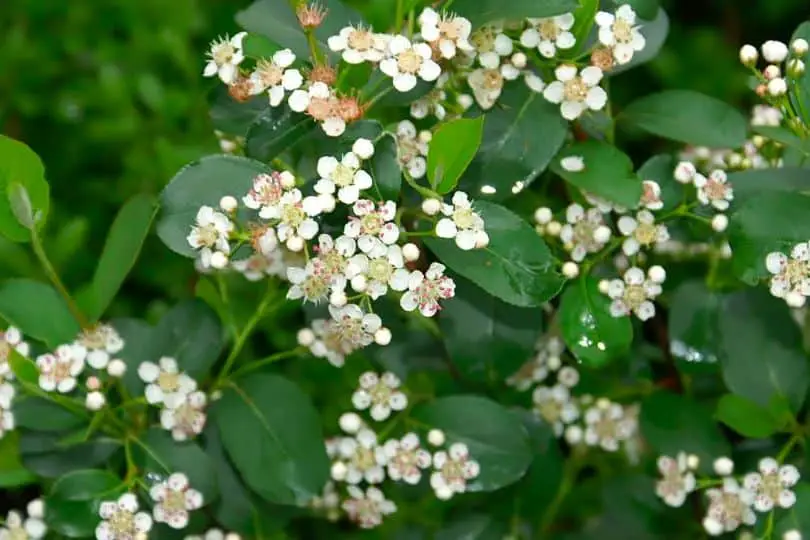
- Scientific Name: Ilex decidua Walt.
- Common Name(s): Deciduous Holly, Possumhaw, Winterberry
- Mature Height: 33.0’
- Native Range: Western Florida to Virginia, west to southern Illinois and Missouri to Oklahoma, south to Texas, in Mississippi throughout
- Fruits/Flowers: Greenish-white, clusters of 3-9
- Uses: Holly fruits are consumed by small mammals, songbirds, and game birds; eaten by white-tailed deer; a good choice for wildlife plantings
The Deciduous Holly, often known as Possumhaw or Winterberry (scientifically known as Ilex decidua Walt.), is a 33.0′ tall tree. Its range extends from western Florida through Virginia, west to southern Illinois and Missouri, and south to Texas. It can also be found in Mississippi. Deciduous Holly leaves are simple, alternating, and deciduous, having an ovate-lanceolate form and coarsely serrate-crenate margins. The leaves are bright green on top and paler on the bottom, while the twigs are light gray.
The tree has drupe fruits that resemble berries and are red-orange in hue. Small animals, songbirds, and game birds eat these fruits. White-tailed deer and cattle also munch on the Deciduous Holly’s leaves and twigs. Because more than 70% of individuals bear fruit, the shrub is an excellent choice for wildlife plantings. When considering its use as a landscape plant, keep in mind that only female trees give fruit.
In the timber sector, the Deciduous Holly has no commercial value. It can be grown from seeds, bare roots, or in a container. It has a moderate lifespan of more than 50 years and is tolerant to shade and moderate drought. The tree grows as an understory tree in lowlands, marshes, along streams, and moist, rich highland soils. The Deciduous Holly prefers soil pH ranging from 3.5 to 6.5, and it grows best in fine to coarse-grained soils.
8. American Holly
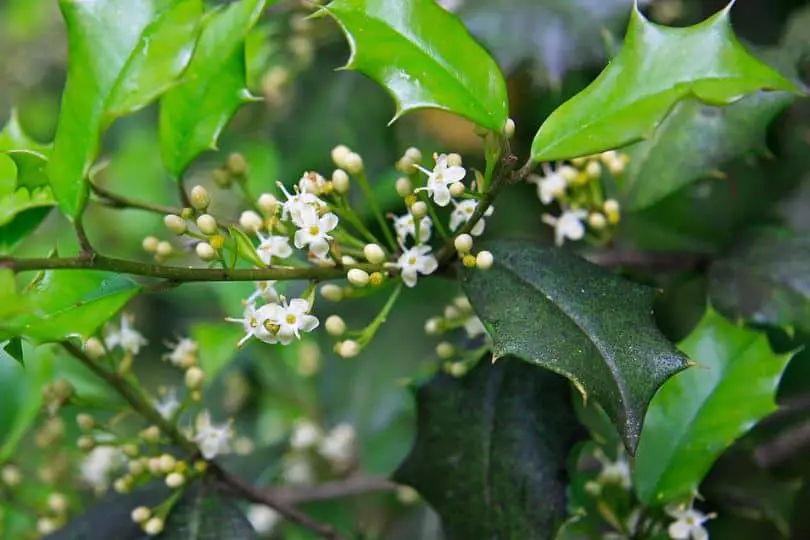
- Scientific Name: Ilex opaca Aiton
- Common Name(s):American Holly
- Mature Height: 60.0′
- Native Range: Massachusetts to Florida; west to Texas and Missouri
- Fruits/Flowers: Greenish-white flowers
- Uses: Wildlife food and ornamental qualities.
The American Holly is a tree with simple, alternating, and persistent leaves. The leaves are oblong-ovate in shape and range in size from 2.0″ to 4.0″ long and 1.0″ to 2.0″ broad. They feature a wavy edge and robust, stiff spines with sharp points.
The leaves are dark green above and lighter greenish-yellow below. American Holly twigs are thick and gray in hue, with glabrous mature surfaces. The tree has spherical, red drupe fruits that contain numerous conspicuously ribbed 1-seeded stones. The American Holly’s flowers are dioecious and appear in cymose clusters. The tree can reach a height of 60.0′ and grows slowly.
The American Holly flourishes in lush, moist bottomlands, wetlands borders, and dry sheltered slopes in a range stretching from Massachusetts to Florida and west to Texas and Missouri. It can also be found near the seaside on sandy soils.
The tree is shade tolerant and has a modest drought tolerance. It is sensitive to fire and anaerobic conditions. American Holly can be grown through seeds, bare roots, containers, and cutting methods. The tree regenerates and has coppicing potential.
The American Holly is important to wildlife. 18 different bird species and white-tailed deer both eat their fruits. The lush foliage of the tree provides cover and nesting habitat for a variety of songbirds.
Despite its low timber demand, the American Holly is occasionally employed for high-value architectural reasons due to its highly white wood. The tree is appreciated in landscaping because of its lovely evergreen foliage and brightly colorful fruits. To keep its attractive shape, it must be pruned regularly.
9. Yaupon
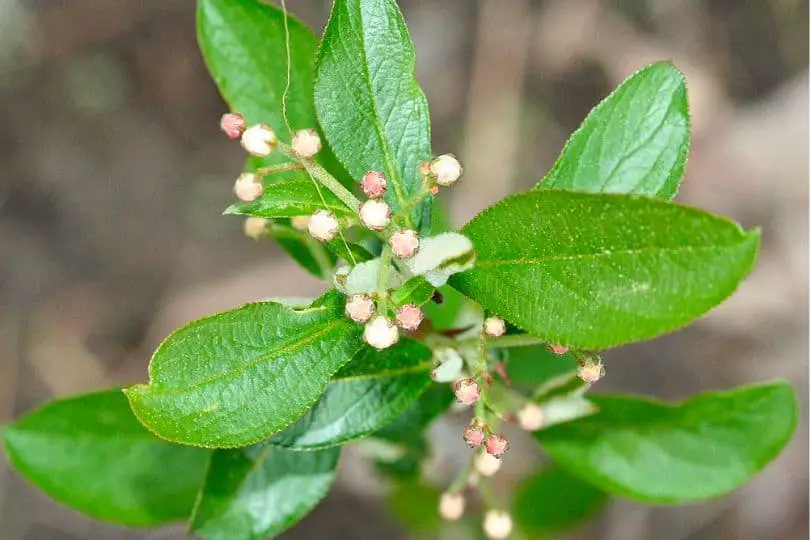
- Scientific Name: Ilex vomitoria Ait.
- Common Name(s): Yaupon evergreen holly, Indian black drink, Christmas berry
- Mature Height: 25.0’
- Native Range: Virginia to Texas and north to Oklahoma and Arkansas
- Fruits/Flowers: White flowers
- Uses: Attracts wildlife, food for songbirds and gamebirds, browsed by white-tailed deer, provides winter cover for wildlife, no commercial value in the timber industry
Yaupon evergreen holly, also known as the Indian black drink or Christmas berry is an evergreen tree with 0.5″ to 1.5″ long and 0.25″ to 0.5″ broad leaves. The leaves are elliptic to elliptic-oblong in form, with a crenate border, obtuse apex, and equilateral base.
The leaves are dark green on top and paler on the bottom, with a shiny surface on top and an opaque surface on the bottom. Pinnate venation is present. The twigs are slender and stiff, with a velvety surface that becomes glabrous and is initially purplish brown before turning light gray. The buds are small and obtuse in shape, dark brown to practically black, and covered in glabrous scales.
The tree has bright red drupe fruits that are berry-like and measure 0.25″ in diameter. The flowers are dioecious, with staminate blooms on slender club-shaped glabrous pedicels and pistillate flowers that are sessile and either single or in pairs. The blooms are grouped in short glabrous cymes and have four white petals. The bark of the yaupon evergreen holly is thin and reddish brown.
Yaupon evergreen holly has numerous stems and matures to a height of 25.0′. It grows slowly, reaching a maximum height of 20.0′ after 20 years. The tree can live for more than 100 years. It can withstand moderate shade and severe drought, but it is sensitive to fire and has no tolerance for anaerobic conditions. It can be grown by seed, bare root, or container methods (cold stratification is necessary). The tree can resprout and coppice.
The yaupon evergreen holly attracts wildlife with its scarlet fruits and is an essential food source for many songbirds, gamebirds, and waterfowl.
Birds such as bluebirds, catbirds, mockingbirds, robins, yellow-shafted flickers, red-naped sapsuckers, yellow-bellied sapsuckers, white-throated sparrows, cedar waxwings, Florida ducks, black ducks, mourning doves, ruffed grouse, bobwhite quail, and wild turkey consume the fruit.
Armadillos, black bears, gray foxes, western foxes, raccoons, and skunks eat it as well. White-tailed deer feed on the tree’s foliage and twigs. During the winter, the yaupon’s evergreen foliage provides cover for wildlife. The tree, on the other hand, has little financial use in the timber sector.
10. Bigleaf Magnolia
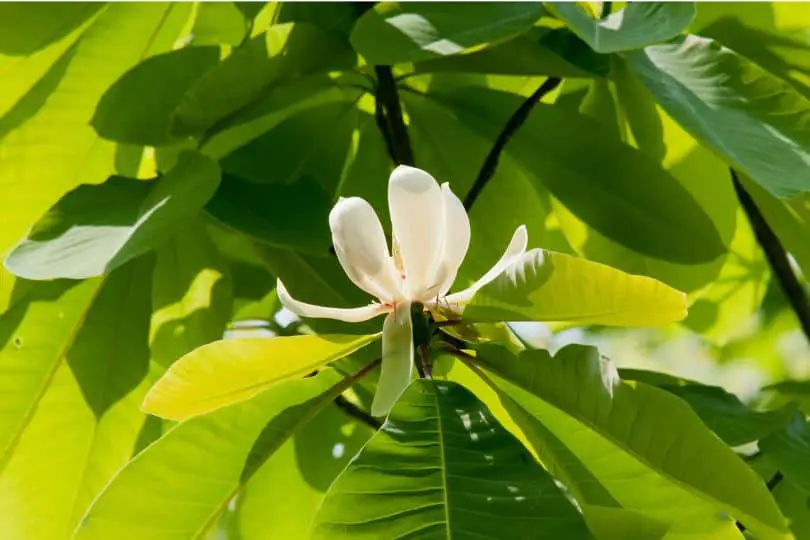
- Common Name: Big Leaf Magnolia
- Scientific Name: Magnolia macrophylla Michx.
- Mature Height: 50.0 feet
- Native Range: Central North Carolina to eastern Louisiana, pockets in Georgia, South Carolina, and northwestern Florida, and parts of Mississippi
- Flowers/Cones/Fruit: Cone-like fruit called aggregate of follicles, rose-colored; large white flowers with a rose-colored blotch at the base
- Uses: Not used for wildlife or timber; may be used as a specimen tree in landscaping
One of the shortest white flowering trees in Mississippi, the big-leaf magnolia, is a tree with big, green leaves that can grow up to 30 inches long. The leaves are bright green on top and silvery gray on the underside.
The tree features huge buds and small yellow-green twigs. It has cone-shaped fruits about 3 inches long and with compressed seeds. Large white flowers with a rose-colored splotch appear on the tree.
The Big Leaf Magnolia can be found in various states, including North Carolina, Tennessee, Alabama, and Louisiana, where it grows in rich, mesic woodlands. It is most common in Mississippi, particularly in coastal and river-bound regions. The tree has no use for wildlife or wood. It can, however, be used as a specimen tree in landscaping, but it takes 12-15 years to bloom.
The blooms and fruit are lovely, but the huge leaves, which degrade slowly, can cause trash.
11. Umbrella Magnolia
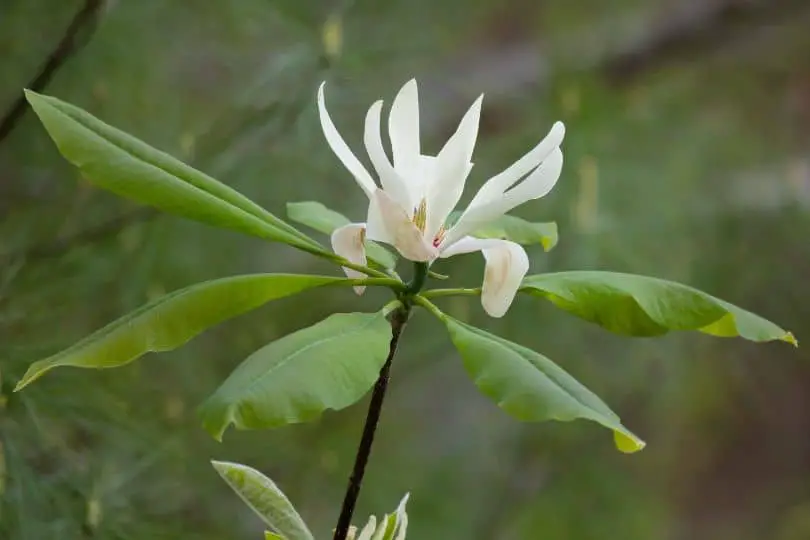
- Common Name: Umbrella Magnolia
- Scientific Name: Magnolia tripetala L.
- Mature Height: 30 ft.
- Native Range: New York and Massachusetts to Florida; west through Mississippi, Arkansas, Oklahoma, and Missouri; northeast to Indiana
- Flowers/Cones/Fruit: Cup-shaped white flowers with a disagreeable odor; conelike, glabrous fruit
- Uses: Medium palatability for browsing and grazing animals; no economic value as a timber product
Umbrella Magnolias are the shortest white flowering trees in Mississippi with a maximum height of 30ft. It is also known as the umbrella tree or elkwood, a species of tree that grows along the Coastal Plain and Piedmont Plateau in damp, fertile bottomlands or along streams.
The Umbrella Magnolia’s leaves are simple, alternating, and deciduous. They are terminally crowded on the twig and are 18-30 inches long and 8-10 inches broad. The leaves are green on top and pale on the bottom. The tree’s bark is gray, thin, and smooth, but it gets shallowly furrowed as it ages.
The Umbrella Magnolia has huge, cup-shaped white blossoms with an unpleasant odor. The flowers are roughly 10-12 inches in diameter and feature 6 or 9 6-10 inch long petals. The tree also produces 2-3 inch large conelike fruits. The seeds inside the fruit are oblong and around 0.5 inches long.
The Umbrella Magnolia is endemic to several eastern states, including New York and Massachusetts, as well as Florida and Arkansas, and Oklahoma. Indiana has it as well. It can be produced from seeds or bare roots and is not widely used in landscaping.
While the Umbrella Magnolia has little wood value, it is a valuable source of forage and pasture for animals. However, it is just mildly appealing to them. It is also worth noting that the Umbrella Magnolia is threatened in some places, like Florida and Indiana, and rare in others, including Pennsylvania.
12. Sweetbay Magnolia
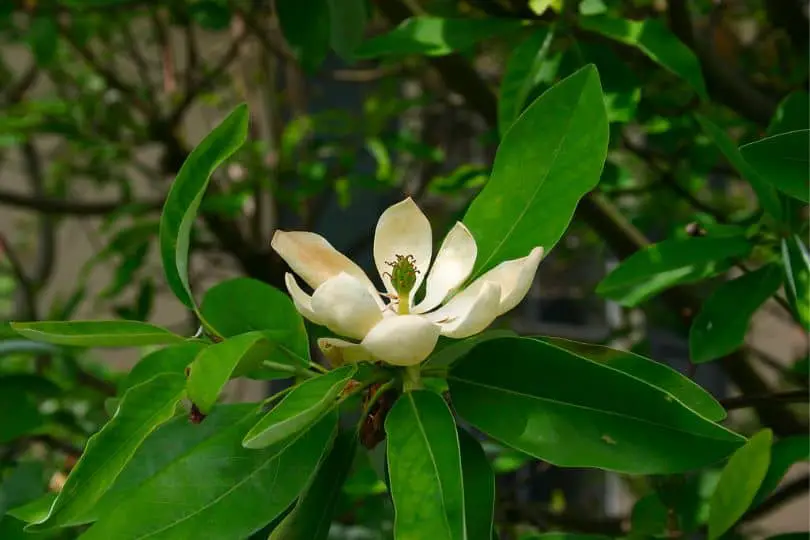
- Common Name: Sweetbay Magnolia
- Scientific Name: Magnolia virginiana L.
- Mature Height: Up to 60 feet
- Native Range: Atlantic and Gulf Coastal Plains from Long Island to southern Florida, and west to eastern Texas
- Flowers/Cones/Fruit: White flowers with a diameter of 2.0 to 3.0 inches; red fruit that hangs from open pods
- Uses: Wildlife food, landscaping projects
Sweetbay Magnolia, also known as swamp-bay, white-bay, or sweet magnolia, is a stunning tree that can reach heights of 60 feet. It has oblong-shaped leaves that are dull green on top and silvery on the underside.
The leaves have a pungent scent. The tree produces fragrant white flowers that range in size from 2.0 to 3.0 inches. These blossoms mature into crimson berries that hang from open pods. The Sweetbay Magnolia can be found on the Atlantic and Gulf Coastal Plains in low, damp forests and river floodplains.
Because of its open appearance and fragrant flowers, it is also often employed in landscaping. This tree’s leaves and twigs are popular for deer and cattle, as well as gray squirrels, white-footed mice, wild turkey, quail, and songbirds.
While the Sweetbay Magnolia has little economic value in terms of lumber, it is nonetheless harvested and used for the same purposes as other magnolias.
13. Chickasaw Plum
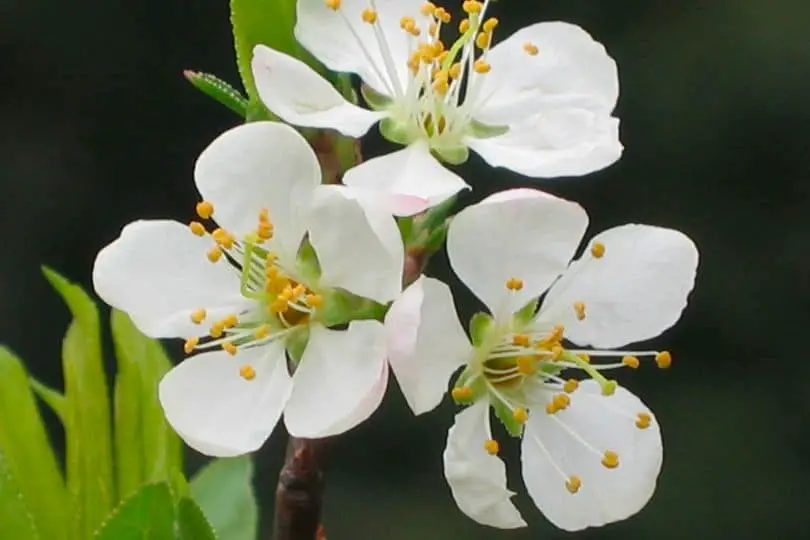
- Scientific Name: Prunus augustifolia Marshall
- Common Name(s):Chickasaw Plum
- Mature Height: 12.0’ – 25.0’
- Native Range: Oklahoma and Texas; north to New Jersey; south to Florida; west to Louisiana; in Mississippi, scattered throughout.
- Fruits/Flowers: White flowers.
- Uses: Fruit eaten by deer, bear, raccoon, squirrel, and birds
The Chickasaw Plums are another variety of short, white flowering trees in Mississippi. It is a deciduous tree that grows to a height of 12.0′ – 25.0′. It is most typically found on sandy soils and in disturbed areas such as roadsides, fence rows, and old fields. The leaves on this tree are brilliant green and lanceolate to oblong-lanceolate in form, with coarsely serrate margins. The leaves are 3.0″ long and 1.0″ wide, with a shiny surface on top and a dull surface on the bottom.
The Chickasaw Plum produces edible drupes, which have a big stone and measure around 0.5″ to 0.75″ in diameter. Drupes are either yellow or red in hue. The tree also has lovely white flowers that are monoecious and flawless. These blooms have five petals and a diameter of 0.33″ to 0.5″ and are found in 4- to 5-flowered umbels. Wildlife such as deer, bears, raccoons, squirrels, and birds consume the tree’s fruits.
Chickasaw Plum cultivation is simple, as it can be grown from seed or transplant. It is frequently utilized as a street tree with a single leader or as a specimen tree with many trunks. It’s also popular on middle strips and commercial property entrance roads.
This tree has excellent resprout/coppice potential and is ideal for use in shrub borders or around patios and decks. It does not, however, produce a neat crown and may appear unkempt over the winter.
14. Carolina Laurel Cherry
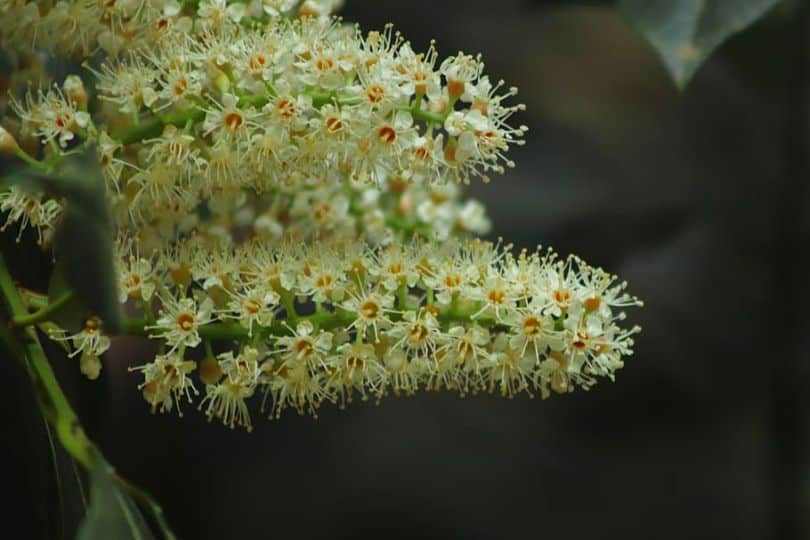
- Scientific Name: Prunus caroliniana (Ait.) Mill.
- Common Name(s): Carolina Laurel Cherry, wild orange, mock orange
- Mature Height: 30.0’ – 40.0’
- Native Range: Native to the Southeastern United States
- Fruits/Flowers: White flower
- Uses: Ornamental, wildlife food.
Carolina Laurelcherry is a deciduous tree native to the southeastern United States. It is also known as “wild orange” or “mock orange.” The tree matures at a height of 30.0′ – 40.0′ and grows at a moderate rate.
Carolina Laurelcherry leaves are simple, alternating, and durable. They have an oblong-lanceolate shape and a dark green tint. The leaves are around 2.0″ – 5.0″ long and 0.75″ – 1.5″ broad. The leaf margins are either whole or slightly serrated, producing a wavy look. The base is wedge-shaped, while the apex is acuminate, generating a short distinct point. The leaves are glossy on top and pallid on the bottom.
The Carolina Laurelcherry bears glossy, dry drupe fruits. They have a diameter of 0.5″ and are oblong. The fruit stone is ovoid with a sharp, rounded base. The fruit fluctuates in hue from black to blue-black. The tree also produces exquisite monoecious flowers. They have five petals and develop in racemes on short axillary stalks. The flower’s center appears white to orangish and is highly noticeable.
Because of its lovely foliage and delicate blossoms, this tree is frequently used as an ornamental. Because of its dense growth habit, it is also widely planted as a privacy hedge or screen.
Although people don’t typically eat fruits, they do offer food and shelter to a variety of wildlife species. The Carolina Laurelcherry is shade and drought-tolerant, but not fire-resistant. It has one or more stem forms and a lifespan of less than 50 years.
15. Black Cherry
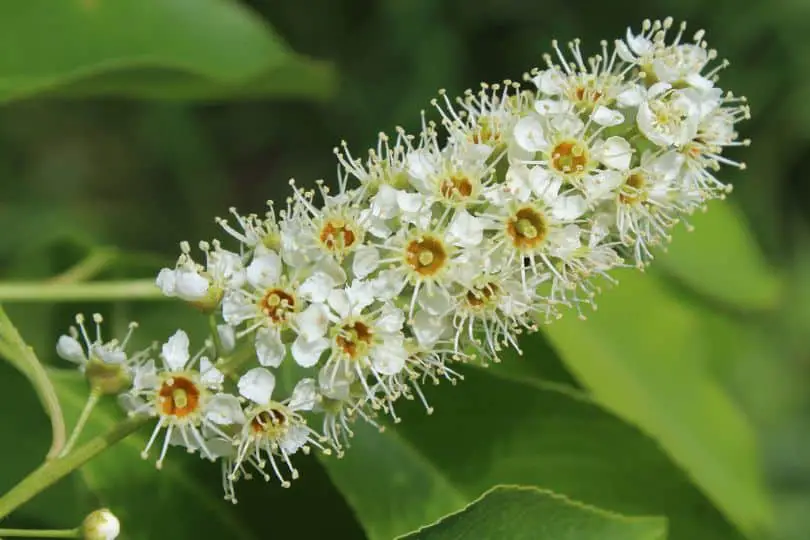
- Scientific Name: Prunus serotina Ehrh.
- Common Name(s): Black Cherry, wild black cherry, rum cherry, mountain black cherry
- Mature Height: 80.0′
- Native Range: Widespread in North America including Mississippi.
- Fruits/Flowers: White flowers & black cherry.
- Uses: Wildlife food, ornamental, toy making, etc.
Black Cherry (Prunus serotina Ehrh.) is a deciduous tree with simple leaves that is also known as wild black cherry, rum cherry, or mountain black cherry. The leaves are 2.0″ – 6.0″ long and 1.0″ – 1.5″ broad, with a dark green upper surface and a whiter below surface. When mature, the twigs are slender and reddish brown in hue. The tree bears tasty drupe fruits that range in color from dark purple to black and have a spherical form. The flowers are white and appear in racemes with numerous blossoms.
Black Cherry grows to a mature height of 80.0 feet and is native to a wide range of habitats, most typically in mixed stands with oaks, ashes, hickories, and yellow poplar. It favors deep, rich, moist soils but will thrive on sandy soils as well. The tree grows quickly and has a modest lifespan of more than 50 years. It is shade-intolerant and has a limited fire tolerance. Black Cherry is found in several states in eastern North America, including Canada, Mexico, and Guatemala.
Many bird species, game birds, and animals such as red foxes, black bears, raccoons, opossums, squirrels, and rabbits feed on the fruits of the Black Cherry tree. Black Cherry wood is highly regarded for its use in cabinets, furniture production, paneling, interior trim, veneers, handles, crafts, toys, and scientific instruments. It is robust, firm, and close-grained, with a deep reddish-brown color.
Black Cherry is an excellent choice for semi-natural woodland gardens. However, because it produces an abundance of luscious fruits in the summer, leaves fall off in the autumn, and a lot of seedlings appear the following spring, it might be too messy for more formal settings.
16. Common Serviceberry
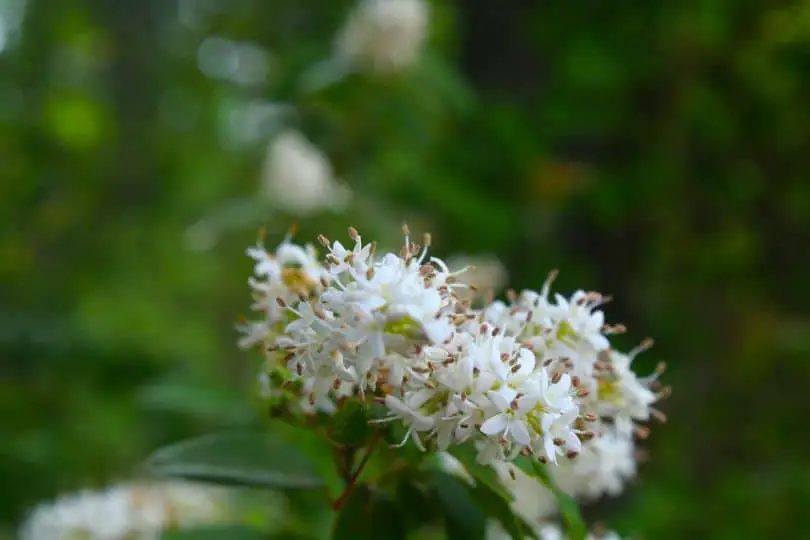
- Scientific Name: Amelanchier aborea (Michx. f.) Fern.
- Common Name(s): Common Serviceberry (Downy), Sarvis-berry, shadblow, shadbush, juneberry, sugarplum, Indian cherry.
- Mature Height: 50.0′
- Native Range: Throughout United States.
- Fruits/Flowers: bell-shaped white flowers.
- Uses: Ornamental, wildlife food.
Downy Serviceberry, also known as Common Serviceberry, is a deciduous tree with simple, alternating leaves. The leaves are oval to oblong in form, yellow-green on top and paler on the bottom.
The tree can reach a height of 50.0′ and grows at a moderate rate. It loves dry limestone soils, slopes, and ridges, but it can also be found on sandy loams found along streams and riverbanks. This tree tolerates shade and is moderately resistant to drought and fire. It has a life expectancy of more than 50 years.
The Common Serviceberry produces little, tasteless berries with numerous small seeds. The fruit is around 0.50″ in diameter and reddish-purple in hue. The tree also has white, bell-shaped flowers in racemes on short stalks. With five obovate petals, these flowers are monoecious and perfect.
The Common Serviceberry is valuable for both wildlife and wood. Over 40 bird species and numerous small and big mammals, including squirrels, foxes, deer, elk, and black bears, rely on fruit and foliage for food and cover. The tree is also used for pulpwood and tool handles.
The Common Serviceberry is a good attractive tree in landscaping. It blooms in early spring and has brilliant fall hues ranging from orange, red, gold, and green blends. It’s an appealing choice because of the edible fruit, and there are various cultivars available with different growth habits, blossom size and color, and leaf color.
17. Southern Catalpa
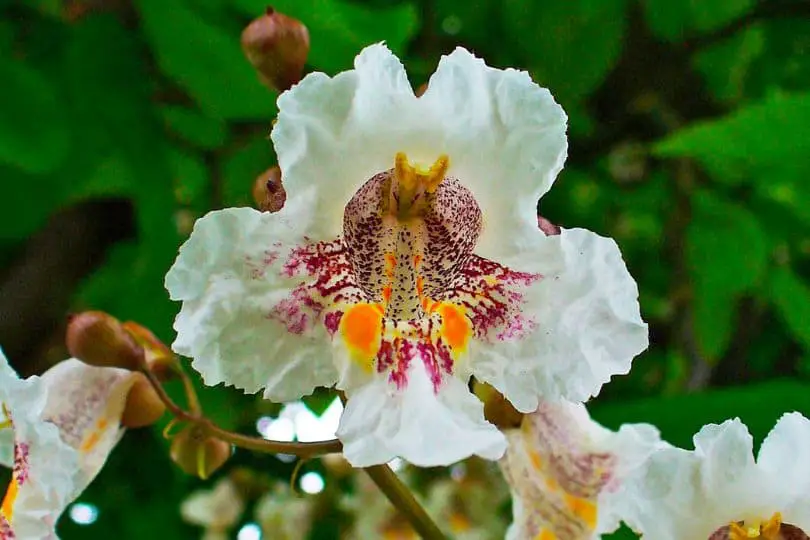
- Scientific Name: Catalpa bignonioides Walt.
- Common Name(s): Southern Catalpa, Indian bean, Caterpillar Tree
- Mature Height: 66.0 feet
- Native Range: Southern United States
- Fruits/Flowers: Purple spotted flowers with white/yellow bands
- Uses: Rapid-growing tree with moderate lifespan; Tolerant to intermediate shade and medium drought; No tolerance to fire or anaerobic conditions.
Southern Catalpa, often known as Indian bean or Caterpillar Tree is a deciduous tree with simple, opposite, or whorled leaves that can grow to be 5.0″ – 6.0″ long and 4.0″ – 5.0″ wide. The leaves are broadly oval, with a heart-shaped base and a pointed to nearly rounded apex, and are light green above and whiter below.
Southern Catalpa twigs are robust and greenish purple in hue, eventually turning gray-brown. On the twigs of the tree, there are visible pale lenticels and oval leaf scars. The terminal bud is absent, but the lateral buds are 0.06″ long, globose in shape, and red-brown in color, with six pointed, overlapping scales covering the buds.
The fruit of the Southern Catalpa is a woody capsule, 6.0″ – 20.0″ long and 0.25″ broad. The capsules are linear to elongate in form, with pointed wings. The capsule fluctuates in hue from dark brown to gray-brown, while the seeds are gray.
Southern Catalpa blossoms are monoecious and perfect. They grow on slender stalks in terminal many-flowered panicles that are 8.0″ – 10.0″ in length. Flower tubules measure 2.0″ long and 2.0″ in diameter, and have wavy petal edges. The throat of the flower is purple with two bands of yellow, which is a more vibrant hue than the Catalpa speciosa variant.
The bark of the Southern Catalpa varies in color from reddish brown to gray and is divided into long, thin, uneven scales. It is a single-crowned tree with a mature height of 66.0 feet.
The Southern Catalpa is a short-lived tree that grows quickly. It can handle some shade and moderate dryness, but not fire or anaerobic conditions. Southern Catalpa is a deciduous tree native to the southern United States. It offers aesthetic value to landscapes with its beautiful purple blossoms and distinctive seed capsules.
It’s also popular because of its fast growth rate and resistance to shade and dryness. It should be noted, however, that it does not withstand fire or anaerobic circumstances. The Southern Catalpa is a popular choice for urban and suburban settings due to its short lifespan.
Similar Articles
- Native Flowering Trees In Mississippi
- Common Fruit Trees In Mississippi
- Native Pine Trees In Mississippi
- Common Palm Trees In Mississippi
- Native Oak Trees In Mississippi
- Common Birch Trees In Mississippi
- Native Elm Trees In Mississippi
- Native Magnolia Trees In Mississippi
- Common Pink Flowering Trees In Mississippi
- Native Purple Trees In Mississippi
- Native Plum & Cherry Trees In Mississippi
- Native Ash Trees In Mississippi
- Native Maple Trees In Mississippi
- Native Cypress Trees In Mississippi
- Native Hickory Trees In Mississippi
- Native Nut Trees In Mississippi
White Flowering Trees In Mississippi – Sources
The Regional Gardening team makes sure that the information in our articles is accurate by only using sources that are known to be trustworthy. Some of these sources are peer-reviewed journals from government agencies, well-known universities, and scientific research organizations.
- Native Trees For Mississippi Landscapes, Mississippi State University Extension.
- Mississippi Trees, Publications Of Mississippi Forestry Commission.
- Department Of Plant & Soil Sciences, Mississippi State University Extension.
- Tree Care, Mississippi Urban Forest Council.


